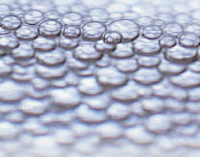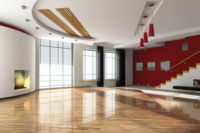Manufacturers and consumers place increasingly stringent demands on both the appearance and functional properties of surfaces. Often, these demands cannot be met by the material alone; rather, the manufacturers turn to innovative and functional coatings to offer the solution. Surfaces such as wood, metal, ceramic, leather and plastics require coatings that give a variety of protective and decorative properties. Besides the aesthetic aspect, these coatings may need to impart corrosion resistance, scratch and mar resistance, clarity, gloss, UV and weathering stability, chemical resistance, nonstick or easy cleaning, and even soft feel properties.
For substrates such as wood, leather and plastics, traditional coatings technology includes acrylics, alkyds, polyesters, nitrocellulose and urethanes. As with every situation, strengths and weaknesses can be seen with each choice. One of the technologies of interest when considering wood, leather and plastics is urethane dispersion chemistry. Coating the substrate with select urethane dispersions can help manufacturers achieve a formidable combination of properties: flexibility, toughness, chemical resistance, clarity and one-component air-drying.(1)
By advancing traditional urethane dispersions and reacting with silicone, Evonik has developed a novel modified resin system: Silikopur® 8080 silicone-modified polyurethane dispersion, which combines the strengths of a urethane dispersion with the hydrophobic nature of silicones. The silicone reacted in the urethane backbone shows improvement with regard to nonstick properties, improved surface cleaning, soft feel and increased mar resistance without sacrificing the advantages of traditional urethanes.(1,2)
Conventional and Silicone-Modified Polyurethane Dispersion Synthesis

|
| Figure 1 Click to enlarge |
Manufacturing conventional polyurethane dispersions (PUDs) typically takes place in a series of steps, as shown in Figure 1. A polyester polyol, an additional diol and dimethylolpropionic acid (DMPA) are reacted with an acid group and two OH groups, as well as a diisocyanate such as isophorone diisocyanate (IPDI). The reaction is engineered so that the DMPA does not react with the diisocyanate through its acid group but, instead, is built into the developing polymer chain. The acid group is neutralized in the subsequent step and acts as a stabilizer for the polymer in the aqueous medium.(1,3)
Unlike conventional PUD synthesis, Evonik’s novel method uses a silicone building block, dihydroxy alkyl polymethylsiloxane, which carries two terminal OH groups, as seen in Figure 2. The choice of the correct silicone building block is essential to the successful development of this dispersion. If the selected silicone chain is too short, the dispersion will have little if any effect on properties. If the selected silicone chain is too long, incompatibility issues may occur, resulting in matte and cloudy films.

|
| Figure 2 Click to enlarge |
The Silikopur 8080 dispersion synthesis consists essentially of three steps, as seen in Figure 3.
First, a polyaddition of the diols is carried out with the isocyanate and the DMPA. In this reaction step, the integration of the silicone in the polymer chain requires accurate and precise mixing ratios due to its incompatibility. DMPA is used to stabilize the molecule, which has been made hydrophobic by the silicone modification, in water. The result of the polyaddition reaction step consists of a molecule with terminal isocyanate functionality that also contains acid groups.

|
| Figure 3 Click to enlarge |
In the second reaction step, these compounds are neutralized with a tertiary amine, which leads to the formation of carboxyl groups. This is the amine neutralized prepolymer step.
In the third and final step, the prepolymer is emulsified with an amine in water. Because the isocyanate groups are more inclined to react with the amine than water, the result is a molecule with a high molecular weight that is present in a stable, aqueous dispersion due to the neutralized carboxyl groups. This step is a “chain-lengthening” process.(1,4,5)
Results and Discussion
The Silikopur 8080 dispersion technology was selected based upon its positive effects with leather, plastics and wood coatings. Furthermore, this novel technology provides manufacturers with a one-component, waterborne N-methyl-2-pyrrolidone-free (NMP-free) coating with the ability to air dry. Furthermore, the Silikopur 8080 formulation maintains hydrophobic properties, as well as excellent flexibility at low temperatures, chemical resistance, mar and scratch resistance, easy-to-clean nonstick properties, and a “soft feel.”
Flexibility and Feel: Furniture and Clothing

|
| Figure 4 Click to enlarge |
Experimentation provided supporting evidence of this innovative new coating technology’s ability to maintain flexibility over a wide range of temperatures and conditions. When working with leather, Silikopur 8080 dispersions can be applied at temperatures from -30 ºC to over 100 ºC without losing flexibility. As seen in Figure 4, the glass transition temperature (Tg) of this technology is lower than -50 ºC. This interesting property helps to minimize the long-term cracking and squeaking of the leather substrate over time. Leather sofas, shoes, chairs and clothing could benefit from maintaining the hydrophobic, soft feel and flexibility, while retaining their release properties.(4,6)
Nonstick: Automotive
When considered for coatings on plastics and leather in automotive applications, the Silikopur 8080 dispersion works well with substrates used in dashboards, steering wheels, car seats and even with ethylene-propylene-diene-rubber (EPDM) components. These EPDM parts are widely used in areas such as door and window moldings on cars. The Silikopur 8080 dispersion offers dramatic benefits for EPDM components due to its superior flexibility over a wide range of temperatures, nonstick properties and the ability to reduce squeaking associated with the “stick-slip” effect. The traditional technology used for these EPDM coatings was fluorine-based, thus having potential adverse effects on the environment. In contrast, NMP-free Silikopur 8080 dispersions offer an eco-friendly substitute for the fluoropolymers.
Chemical and Abrasion Resistance: Flooring and Furniture

|
| Table 1 Click to enlarge |
Our experiment next investigated the performance of Silikopur 8080 dispersions with wood substrates, focusing on chemical resistance and abrasion. Because of its hydrophobic behavior, the modified dispersion provides short-term protection against typical household chemicals such as beer, red wine, white wine, acetic acid, ammonia, mustard and ketchup.
As shown in Table 1, four different formulations were used to evaluate the chemical resistance of common household items. Formulas 1 and 2 utilized Acrylic Emulsion A: blended with the Silikopur 8080 product in Formula 1; and, with a conventional PUD in Formula 2.

|
| Table 2 Click to enlarge |
As apparent from chemical resistance test results in Table 2, the formulation with the Silikopur 8080 improved the chemical and stain resistance in 1 hour spot tests. Formulas 3 and 4 used a different acrylic with a higher glass transition temperature: blended with Silikopur 8080 product in Formula 3; and, with conventional PUD in Formula 4. The results illustrate a trend similar to that in Formulas 1 and 2, with the Silikopur 8080 blend showing substantial improvements compared with the conventional PUD blend.

|
| Figure 5 Click to enlarge |
Abrasion and scratch resistance are key performance parameters when formulating coatings for wood flooring and furniture. Taber abrasion studies proved that 30%-by-total-weight Silikopur 8080 dispersion blended with acrylic emulsions (Table 3, Formulation 3) significantly improves mar and abrasion resistance (Figure 5).
It should be noted that when using greater than 30% blends of the urethane dispersions, as seen in Figure 5 data, the additional content does not increase abrasion resistance but actually decreases the effect. However, at the 30% blend mark, the Silikopur 8080 modification shows significant benefit compared to the conventional PUD.

|
| Figure 6 Click to enlarge |
Figure 5 provides a graphical analysis of the Taber Abrasion at both 500 cycles and 1000 cycles using a CS-17 wheel with a 1000-gram weight. As seen in Figure 6, the Silikopur 8080 dispersion provides a significant improvement in abrasion resistance with only 32 mg of weight loss at 500 cycles and 64 mg at 1000 cycles.(4,7)
Conclusion
The development of the Silikopur 8080 dispersion, with its novel chemistry associated with silicone modification of urethane dispersions, shows benefit in a number of different applications such as wood, leather and plastics. When using the Silikopur 8080 system, the data reveals improved properties such as chemical, stain and abrasion resistance, as well as flexibility at low temperatures. Also noted in the results is the ability to blend with acrylic emulsion chemistry to achieve an improved range of properties. Therefore, whether employing Silikopur 8080 dispersion either as a sole binder or as a resin incorporated into a blended system, coatings manufacturers and users can improve performance properties while maintaining the aesthetic qualities required in these markets.
This paper was presented at the 37th Annual Waterborne Symposium, New Orleans, 2010.




Report Abusive Comment